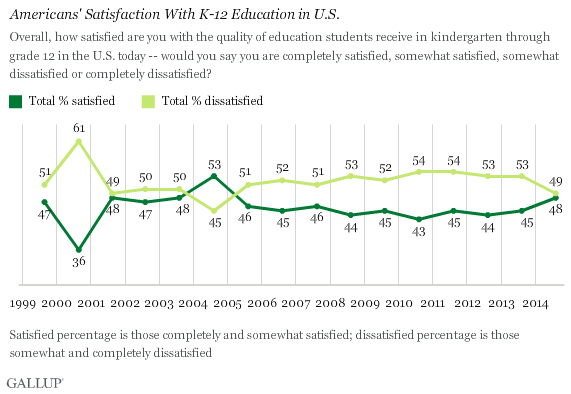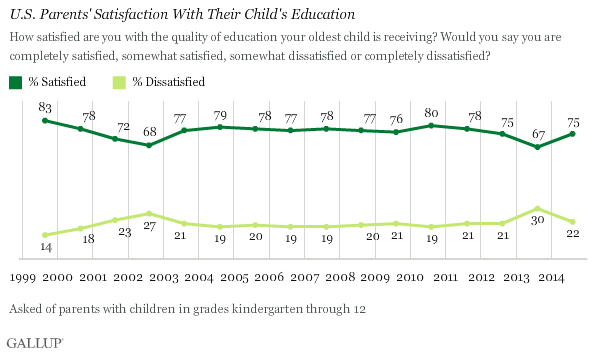Americans' Satisfaction With Education System Increases
In 2014, 48% of Americans are satisfied with the quality of K-12 education
WASHINGTON, D.C. -- As students return to school in the U.S., 48% of Americans are "completely" or "somewhat satisfied" with the quality of kindergarten through high school education in the country, the highest Gallup has measured since 2004. For the first time since 2007, Americans are now about as likely to say they are satisfied as dissatisfied.

Gallup has asked U.S. adults about their satisfaction with education since 1999, including each August since 2001, as part of its annual Work and Education poll. The high of 53% satisfaction was reached in 2004, the only year more Americans were satisfied with education than dissatisfied. Americans were most negative about the state of education in 2000, when education was a major presidential campaign issue and more than six in 10 said they were dissatisfied.
Satisfaction has largely been stable in recent years, ranging from 43% to 46% from 2005-2013. However, satisfaction ticked up this year, and is now similar to what was seen in the early 2000s.
Americans who have children in grades K-12 are generally more satisfied than U.S. adults as a whole. A majority of these parents (57%) are satisfied with education in the country. Parents may be basing their evaluations at least partly on their own child's education, not just on what they hear in the news.
Three in Four Parents Are Satisfied With Their Child's Education
Parents' tendency to be more positive than the general public about education is vividly evident when Gallup asks parents with a child in grades K-12 about their satisfaction with their own child's education. Three in four parents say they are satisfied with the quality of education their oldest child is receiving in 2014, significantly higher than the 48% of Americans who are satisfied with U.S. K-12 education in general.

The 75% of parents who are satisfied with their own child's education is consistent with what Gallup has measured in prior years, although satisfaction was a bit lower last year, at 67%.
Implications
For as long as Gallup has measured it, U.S. parents of school-aged children are more likely to be satisfied with the quality of their child's education than Americans are with the quality of education in the country. Most parents are satisfied with their child's education, while historically the majority of Americans have been dissatisfied with the quality of U.S. education. This long-evident "optimism gap" may result from Americans focusing on press reports of inadequate schooling in problem school districts when they are asked about education nationally, but focusing on what they perceive as a much more positive local situation when asked about the education of their own children.
Survey Methods
Results for this Gallup poll are based on telephone interviews conducted Aug. 7-10, 2014, a random sample of 1,032 adults, aged 18 and older, living in all 50 U.S. states and the District of Columbia.
For results based on the total sample of national adults, the margin of sampling error is ±4 percentage points at the 95% confidence level.
For results based on the sample of 221 parents with children in kindergarten through grade 12, the margin of sampling error is ±9 percentage points at the 95% confidence level.
Interviews are conducted with respondents on landline telephones and cellular phones, with interviews conducted in Spanish for respondents who are primarily Spanish-speaking. Each sample of national adults includes a minimum quota of 50% cellphone respondents and 50% landline respondents, with additional minimum quotas by time zone within region. Landline and cellular telephone numbers are selected using random-digit-dial methods. Landline respondents are chosen at random within each household on the basis of which member had the most recent birthday.
Samples are weighted to correct for unequal selection probability, nonresponse, and double coverage of landline and cell users in the two sampling frames. They are also weighted to match the national demographics of gender, age, race, Hispanic ethnicity, education, region, population density, and phone status (cellphone only/landline only/both, and cellphone mostly). Demographic weighting targets are based on the most recent Current Population Survey figures for the aged 18 and older U.S. population. Phone status targets are based on the most recent National Health Interview Survey. Population density targets are based on the most recent U.S. census. All reported margins of sampling error include the computed design effects for weighting.
In addition to sampling error, question wording and practical difficulties in conducting surveys can introduce error or bias into the findings of public opinion polls.
For more details on Gallup's polling methodology, visit www.gallup.com.
